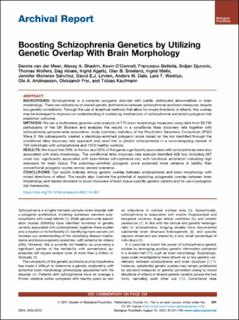| dc.contributor.author | van der Meer, Dennis | |
| dc.contributor.author | Shadrin, Alexey | |
| dc.contributor.author | O'Connell, Kevin Sean | |
| dc.contributor.author | Bettella, Francesco | |
| dc.contributor.author | Djurovic, Srdjan | |
| dc.contributor.author | Wolfers, Thomas | |
| dc.contributor.author | Alnæs, Dag | |
| dc.contributor.author | Agartz, Ingrid | |
| dc.contributor.author | Smeland, Olav Bjerkehagen | |
| dc.contributor.author | Melle, Ingrid | |
| dc.contributor.author | Sánchez, Jennifer Monereo | |
| dc.contributor.author | Linden, David E.J. | |
| dc.contributor.author | Dale, Anders | |
| dc.contributor.author | Westlye, Lars Tjelta | |
| dc.contributor.author | Andreassen, Ole | |
| dc.contributor.author | Frei, Oleksandr | |
| dc.contributor.author | Kaufmann, Tobias | |
| dc.date.accessioned | 2022-09-12T09:24:39Z | |
| dc.date.available | 2022-09-12T09:24:39Z | |
| dc.date.created | 2022-05-20T14:42:40Z | |
| dc.date.issued | 2022 | |
| dc.identifier.issn | 0006-3223 | |
| dc.identifier.uri | https://hdl.handle.net/11250/3017175 | |
| dc.description.abstract | Background
Schizophrenia is a complex polygenic disorder with subtle, distributed abnormalities in brain morphology. There are indications of shared genetic architecture between schizophrenia and brain measures despite low genetic correlations. Through the use of analytical methods that allow for mixed directions of effects, this overlap may be leveraged to improve our understanding of underlying mechanisms of schizophrenia and enrich polygenic risk prediction outcome.
Methods
We ran a multivariate genome-wide analysis of 175 brain morphology measures using data from 33,735 participants of the UK Biobank and analyzed the results in a conditional false discovery rate together with schizophrenia genome-wide association study summary statistics of the Psychiatric Genomics Consortium (PGC) Wave 3. We subsequently created a pleiotropy-enriched polygenic score based on the loci identified through the conditional false discovery rate approach and used this to predict schizophrenia in a nonoverlapping sample of 743 individuals with schizophrenia and 1074 healthy controls.
Results
We found that 20% of the loci and 50% of the genes significantly associated with schizophrenia were also associated with brain morphology. The conditional false discovery rate analysis identified 428 loci, including 267 novel loci, significantly associated with brain-linked schizophrenia risk, with functional annotation indicating high relevance for brain tissue. The pleiotropy-enriched polygenic score explained more variance in liability than conventional polygenic scores across several scenarios.
Conclusions
Our results indicate strong genetic overlap between schizophrenia and brain morphology with mixed directions of effect. The results also illustrate the potential of exploiting polygenetic overlap between brain morphology and mental disorders to boost discovery of brain tissue–specific genetic variants and its use in polygenic risk frameworks. | en_US |
| dc.language.iso | eng | en_US |
| dc.publisher | Elsevier | en_US |
| dc.rights | Navngivelse 4.0 Internasjonal | * |
| dc.rights.uri | http://creativecommons.org/licenses/by/4.0/deed.no | * |
| dc.title | Boosting Schizophrenia Genetics by Utilizing Genetic Overlap With Brain Morphology | en_US |
| dc.type | Journal article | en_US |
| dc.type | Peer reviewed | en_US |
| dc.description.version | publishedVersion | en_US |
| dc.rights.holder | Copyright 2021 Society of Biological Psychiatry | en_US |
| cristin.ispublished | true | |
| cristin.fulltext | original | |
| cristin.qualitycode | 2 | |
| dc.identifier.doi | 10.1016/j.biopsych.2021.12.007 | |
| dc.identifier.cristin | 2026012 | |
| dc.source.journal | Biological Psychiatry | en_US |
| dc.source.pagenumber | 291-298 | en_US |
| dc.identifier.citation | Biological Psychiatry. 2022, 92 (4), 291-298. | en_US |
| dc.source.volume | 92 | en_US |
| dc.source.issue | 4 | en_US |

